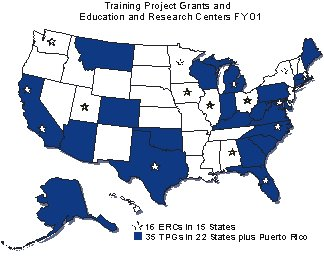Training Occupational Safety and Health Professionals
June 2001
DHHS (NIOSH) Publication Number 2001-158

Fact Sheet
The High Cost of Death and Disease On the Job
Each day an average of 9,000 U.S. workers sustain disabling injuries on the job, 16 workers die from an injury at work, and 137 workers die from work-related diseases. Data from a study published in 1997 funded by the National Institute for Occupational Safety and Health (NIOSH) showed that in 1992, the economic costs of job-related injuries and illnesses totaled $171 billion.
These costs are much higher than those for AIDS and Alzheimer’s Disease and are on a par with those for cancer and circulatory disease. However, there are not enough well-trained occupational safety and health (OS&H) professionals to meet this large burden of disease and injury.
Impact of NIOSH Training Programs
The Occupational Safety and Health Act directs NIOSH to fund training programs to educate professionals in the OS&H disciplines (industrial hygiene, occupational health nursing, occupational medicine, and occupational safety). To date, these programs have had a significant public health impact:
- An average of 700 students graduate annually from NIOSH-supported programs with training in medicine, nursing, industrial hygiene, and safety engineering.
- NIOSH estimates that about half of all U.S. occupational safety and health professionals graduate from NIOSH-supported programs at the Masters and Doctorate levels.
- A 1995 report by the Inspector General of the Department of Health and Human Services noted that approximately 80% of the graduates from NIOSH-funded programs pursue careers in OS&H.
- NIOSH funds more than 1,000 continuing education courses each year with upwards of 30,000 participants.
Education and Research Centers (ERCs)
NIOSH supports regional centers that provide multi-disciplinary academic and research training programs in the core OS&H disciplines, as well as continuing education and outreach programs. There are 16 ERCs at leading universities in 15 states nationwide (see map). The total budget for the 16 ERCs in fiscal year (FY) 2000 was $11.9 million. Two hundred and two students were graduated from ERCs during 2000, with approximately 1000 students enrolled in the academic programs. Also in FY 2000, ERCs trained 33,491 students in continuing education programs and conducted regional outreach efforts.
Training Project Grants (TPGs)
In FY 2000, NIOSH administered a $2.3 million program supporting 35 single-discipline TPGs in 22 states and Puerto Rico (see map). TPGs provide training in occupational medicine, occupational health nursing, occupational safety, industrial hygiene, and other specialized OS&H training areas. In 2000, the programs enrolled 863 full-time and 485 part-time occupational safety and health professionals.
Fire Fighter Training
NIOSH supports training for approximately 3,700 fire fighters and emergency responders. The training program teaches procedures for handling emergencies involving hazardous materials, such as chemical spills.
Occupational Health Psychology
Workplace psychosocial and organizational factors have been associated with a range of serious health risks, including job stress and psychological disorders, cardiovascular disease, and musculoskeletal disorders. However, professional training programs that prepare researchers and practitioners to address these areas of concern are uncommon in the United States. To fill the gap, NIOSH funds the American Psychological Association to develop and implement graduate level training programs at major universities that provide cross-disciplinary training in workplace psychosocial factors, work organization, and occupational safety and health. Thus far, training programs of this nature have been implemented at 11 universities nationwide.
Health Services Research Training
NIOSH funds training for researchers to conduct health services research at four Education and Research Centers (MN, NC, WA and MA) in the OS&H field. This includes an assessment of how health care is organized and funded and of the effectiveness of treatment and prevention for work-related diseases and injuries.
Training Videos
NIOSH offers several training videos on specific occupational safety and health topics. These videos provide information on methods to control occupational exposures and other safety and health hazards in the manufacturing, construction, mining, and health care sectors, as well as other training material relevant to OS&H professionals. Look here for a listing of available videos.
International Training
NIOSH, along with the Fogarty International Center and the National Institute of Environmental Health Sciences (both of NIH), the National Center for Environmental Health (CDC), and the Environmental Protection Agency, supports the International Training and Research Program in Environmental and Occupational Health (ITREOH). Through this program, scientists from 27 developing countries receive training at 13 U.S. institutions to conduct standardized assessment and monitoring of environmental and occupational health hazards and to prepare for the coordinated conduct of scientific studies and interventions worldwide. Training is supported in basic research, epidemiologic methodologies, environmental and occupational hazard assessment, engineering control, and prevention.
The Future of OS&H Training
The American workforce is becoming more diverse in age, gender, race and nationality. Moreover, major changes are occurring in work organization due to changes in economic conditions, technology, corporate employment practices, and demographics. These changes complicate the implementation of workplace health and safety programs and necessitate more comprehensive, multi-disciplinary training and new types of training programs and delivery systems.
To explore the demands on occupational safety and health professionals in this changing environment, the Institute of Medicine (IOM) conducted a workforce needs assessment. In this recently released report entitled Safe Work in the 21st Century: Education and Training Needs for the Next Decade’s Occupational Safety and Health Personnel, the IOM made recommendations to strengthen current and future OS&H training. NIOSH supports in particular the IOM recommendations to focus a new training initiative on injury prevention and to broaden training support beyond the traditional OS&H disciplines. NIOSH believes future efforts need to explore and support the special needs of older, female, and ethnic/cultural groups of minority workers, and to encourage alternatives to traditional education and training programs, such as distance-based learning.
Training Occupational Safety and Health Professionals [PDF – 86 KB]

